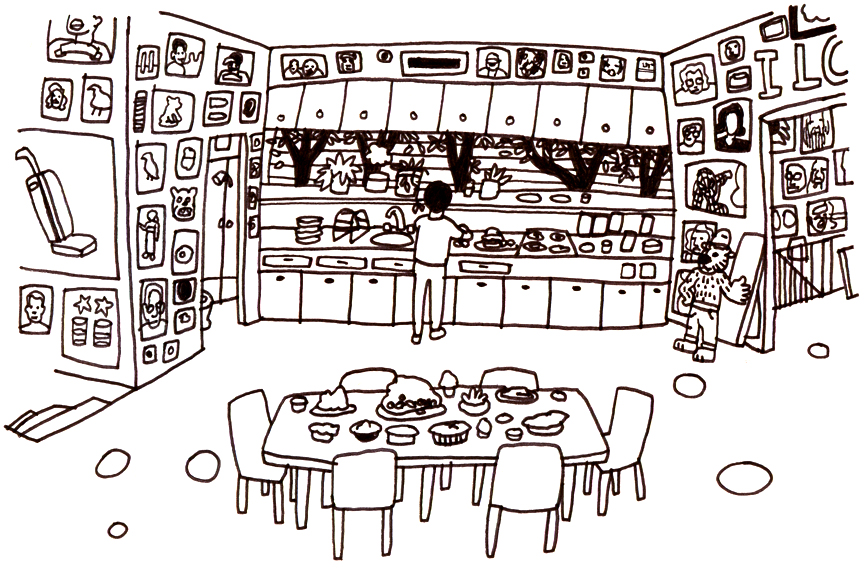Derek Erdman is regularly called a Pop Artist, and this is understandable given that his tactics appear to intensify the preoccupations of the Factory tradition. Over the last decade Erdman has developed an increasingly efficient method for producing batches of art that he can make quickly, duplicate easily, and sell cheaply. According to this method his energy is concentrated in the plan (selecting source materials from which he will ‘borrow’ imagery), and the execution of each piece becomes semi-automatic, a series of choreographed tasks that he can carry out much like an assembly liner or a tap dancer might perform his job. The subjects of his paintings (second-tier celebrities, flash-in-the-pan current events, obsolete advertisements) are almost always borrowed from the moving spotlight of popular attention, and so the pieces themselves take on the form of commercial debris, relics of the recent surface-past. Occasionally they even turn up in thrift stores. In displaying and distributing his work (paintings, but also magazines, CDs, and pranks of all kinds), Erdman has demonstrated an unwavering preference for the banal and the widespread, favoring newsstands, restaurants, building sides, and balloons over galleries. And he has become an expert at harnessing the special hype-magic of the Internet (along with the party and various other spectacle-events that will circulate later in other people’s stories), which he uses not only as a mass-marketplace, but also to cultivate his own semi-celebrity, which carries his work, infusing it with everyday myth. If these strategies suggest a play on Warhol’s program, albeit one in which the artist succeeds in single-handedly developing an everyman’s art market quite separate from the other one, Erdman’s alignment with this tradition is hardly on purpose. (Derek after all has no arts training, nor has he bothered to become particularly familiar with the history of 20th Century high art). Instead, Erdman’s Pop tendencies emerged almost accidentally in his attempts to solve practical problems using what he had at hand, which was very little other than a firm grasp of what, at any given moment, was up. As Erdman tells it in one version of his own history, his Career as an artist began one day when he saw a cut-out painted sheep in his Pilsen stairwell, stole it, felt guilty, returned it, and had to figure out how to make one of his own. Regardless of how much stock is put in this story as any kind of beginning (Erdman had already been crafting elaborate pranks for almost twenty years), it shows his driving practical imperative. What began as a simple project—recognize needs, and figure out how to fill them—has over the years blossomed into a full-blown Hucksterism—create popular needs (the need for a hamburger in the mail, say, or a telephoned revenge rap) to fill. (It makes sense then that lately Erdman’s work has moved more and more toward a set of public services collected under the umbrella company Fantastic Industries.) What Erdman’s project has required, above all, is a finely tuned attentiveness to what his audience believes they want and an absolute willingness to work out these wants in material form no matter what (evidence: hundreds of panda paintings). Erdman’s creative decisions are pushed along by his audience’s desire to find what they already know, and he in turn pushes these desires slightly toward the unexpected (turning cute into creepy, sick into sentimental). Such is the recipe for actual entertainment. While wrestling with what the audience wants stays the secret of most Real Art, it becomes the explicit subject in Erdman’s paintings, as well as in his pranks (on the promise and pitfalls of audience satisfaction see, for example, his early Diane Files or the notorious Kathy McGinty collaboration with Julia Rickert). Unlike his Pop predecessors, Erdman’s paintings are not meditations on the shiny coldness of market interactions, nor are they clever declarations about the end of art. Instead, they are exercises in turning commercial surfaces back into a folk tradition, a truly popular lexicon, which we can playfully control. If his paintings are flat and bright—and they are incredibly, stubbornly so—it is because they are the coins in this constant exchange, the tokens of an unfolding common language of serious puns and half-jokes being shot back and forth between Erdman and his fans. The fan is the single constant, the only truly necessary piece in Erdman’s game, and to play it, the artist himself becomes a super-fan of the constantly shifting popular landscape, faithfully reproducing how it delights and disgusts. What results is a collapsing of the personal and the public in Erdman’s work, and in his life—a collapse that Erdman has embraced perhaps more than any other artist. Just as he re-frames the seemingly impersonal stuff of mass-publicity (celebrities, news events, commercials) as the shared familiars in our common biography, so too do the workings of Erdman’s private life become his material for public entertainment. No detail, no matter how mundane or potentially damaging to himself or his audience, is spared from consideration (the examples are endless, but see for instance the fallout of his recent appearance at Pecha Kucha in Chicago). All this may seem quite megalomaniacal. It is. But in the end it is also the opposite. In a way Warhol would never have tolerated, Erdman perpetually offers his fans absolute artistic control of his fate (gleefully handing over his Myspace password, for instance, so that anybody might tinker with his brand). In doing so he illuminates his own celebrity, like all the others, as the people’s creation. --Hannah Woodroofe (February 2011 Youngstown, Ohio) |
